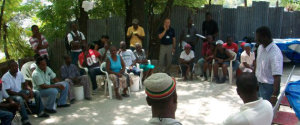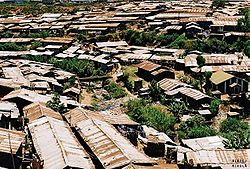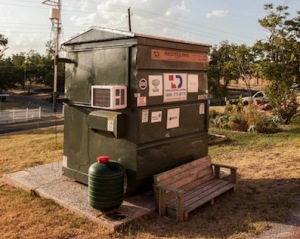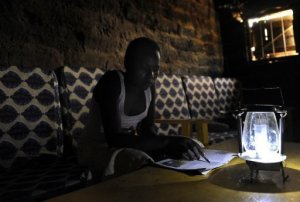Al Jazeera ~ Tondo: The Story Of Manila’s Largest Slum
Historian Carlos Celdran explains how the slums of Tondo came into existence as the rebel district of Manila.
David Weiss – From Slums To Significance: The Communities Shaping Our Urban Future

Photo: A meeting of Global Communities staff and community members of Ravine Pintade to plan the reconstruction of the neighborhood.
urb.im.September 2014. The two megatrends of demographic growth and urbanization are rapidly transforming human settlement from rural to predominantly urban environments. This is particularly true in Asia and Africa, where the UN forecasts that the urban population will grow from 2.3 billion people in 2011 to 4.5 billion in 2050. Many large cities in these regions are struggling with how to provide services, housing and jobs for large numbers of rural migrants. These migrants are often highly vulnerable: although they have moved to the city in search of jobs and access to services, the informal neighborhoods that receive them lack infrastructure and are often removed from main centers of economic activity. A lack of economic opportunities and poor living conditions set the stage for marginalization, instability and violence.
At the same time, this raw influx of human capital, ideas and energy are at the core of providing sustainable answers to the challenges that cities face. Too often slum dwellers have been considered a problem. I believe they are the solution.
Read more: http://urb.im/blog/urbimedge
James Hamblin – Living Simply In A Dumpster
theatlantic.com. September 2014. Tucked behind the women’s residence halls in a back corner of Huston-Tillotson University’s campus in Austin, Texas, sits a green dumpster. Were it not for the sliding pitched roof and weather station perched on top, a reasonable person might dismiss the box as “just another dumpster”—providing this person did not encounter the dean of the University College Jeff Wilson living inside.
Professor Wilson went to the dumpster not just because he wished to live deliberately, and not just to teach his students about the environmental impacts of day-to-day life, and not just to gradually transform the dumpster into “the most thoughtfully-designed, tiniest home ever constructed.” Wilson’s reasons are a tapestry of these things.
Until this summer, the green dumpster was even less descript than it is now. There was no sliding roof; Wilson kept the rain out with a tarp. He slept on cardboard mats on the floor. It was essentially, as he called it, “dumpster camping.” The goal was to establish a baseline experience of the dumpster without any accoutrements, before adding them incrementally.
Read more: http://www.theatlantic.com/features/archive/2014/09/the-simple-life-in-a-dumpster/379947/
Watch This Film About How Simple Solar Lamps Can Transform The Developing World
fastcoexist.com. September 2014. If you were to pick a social invention with greatest bang-for-buck value, you might plump for a solar lamp. These cheap simple devices are life-changing because they’re relatively cheap, simple to use, and have so many knock-on benefits for communities that have traditionally used kerosene lamps and candles.
This nicely made film comes via Great Lakes Energy, a solar supplier in East Africa, and the Global Brightlight Foundation, U.S. nonprofit that developed a lightweight lamp powered with a portable solar panel. It focuses on the Kiziba Refugee Camp in Rwanda and shows how 3,700 households there have benefited from the technology.
Read & watch: http://www.fastcoexist.com/watch-this-film
Nairobi Noir – A Street Photography Project
Mwaura Samora – Why Living In Nairobi Slums Is A Living Hell For The Young, Old And Pregnant
 standardmedia. September 2014. Kenya is still grappling with the affliction of ignorance, disease and poverty 50-plus years after independence. Those living 100 metres below the poverty line in slums are particularly worse off, according to a recent report by African Population and Health Research Center (APHRC).
standardmedia. September 2014. Kenya is still grappling with the affliction of ignorance, disease and poverty 50-plus years after independence. Those living 100 metres below the poverty line in slums are particularly worse off, according to a recent report by African Population and Health Research Center (APHRC).
A bed of roses is never found in the slums. And so is access to medication, clean water or school that can churn out ‘national school materials.’
A girl in the slums is easily made aware of her sexuality when she’s barely as high as her mother’s waist. By then, she would have elicited excitement amongst boys who lust for her. These are boys who are hardly in their teens and would be already familiar with ‘bomu’ (bhang), small kids who are likely to end up in the slammer by the time they are 12. These are the unfortunate lot brought and bred in the sprawling slums of Jangili, Kosovo, Kibera Laini Saba, Kisumu Ndogo, Soko Mjinga and other informal settlements that choke Nairobi.
Disadvantaged lot
In these settlements, life is short and brutal and you are likely kick your ice bucket before time, thanks to crime and the unforgiving violence in the neighbourhoods, where abortion, alcohol-related deaths and police brutality are commonplace.
Read more: http://www.standardmedia.co.ke/pregnant/thenairobian/





